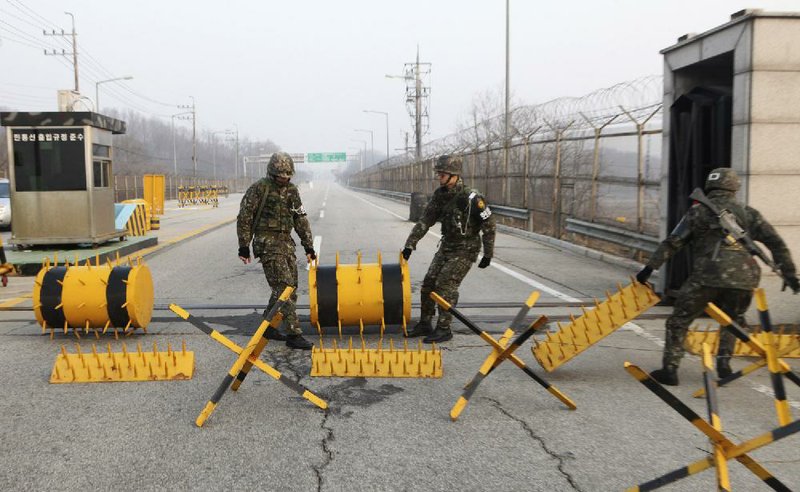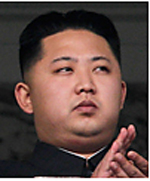SEOUL, South Korea - After a series of escalating threats, North Korea has moved a missile with “considerable range” to its east coast, South Korea’s defense minister said Thursday. But he emphasized that the missile was not capable of reaching the United States and that there are no signs that the North is preparing for a full scale conflict.
North Korea has been railing against U.S.-South Korean military exercises that began in March and are to continue until the end of this month. The allies insist the exercises in South Korea are routine, but the North calls them rehearsals for an invasion and says it needs nuclear weapons to defend itself. The North also has expressed anger over tightened U.N. sanctions for its February nuclear test.
Analysts say the ominous warnings in recent weeks are probably efforts to provoke softer policies from South Korea, to win diplomatic talks with Washington and to solidify the image of young North Korean leader Kim Jong Un. Many of the threats come in the middle of the night in Asia - daytime for the U.S. audience.
The report of the movement of the missile came hours after North Korea’s military warned that it has been authorized to attack the U.S. using “smaller, lighter and diversified” nuclear weapons. The reference to smaller weapons could be a claim that North Korea has improved its nuclear technology, or a bluff.
The North is not believed to have mastered the technology needed to miniaturize nuclear bombs enough to mount them on long-range missiles. Nor has it demonstrated that those missiles, if it has them at all, are accurate.
South Korean Defense Minister Kim Kwan-jin said he did not know the reasons behind the North’s missile movement and that it “could be for testing or drills.”
He dismissed reports in Japanese media that the missile could be a KN-08, which is believed to be a long-range missile that, if operable, could hit the United States.
Kim told lawmakers at a parliamentary committee meeting that the missile has “considerable range” but not enough to hit the U.S. mainland.
The range he described could refer to a mobile North Korean missile known as the Musudan, believed to have a range of 1,800 miles. That would make Japan and South Korea potential targets - along with U.S. bases in both countries - but there are doubts about the missile’s accuracy.
The Pentagon announced that it will hasten the deployment of a missile-defense system to the U.S. Pacific territory of Guam to strengthen regional protection against a possible attack.
Experts say North Korea has not shown that it has accurate long-range missiles. Some suspect that an apparent long-range missile unveiled by the North at a parade last year was actually a mock-up.
“From what we know of its existing inventory, North Korea has short- and medium-range missiles that could complicate a situation on the Korean Peninsula [and perhaps reach Japan], but we have not seen any evidence that it has long-range missiles that could strike the continental U.S., Guam or Hawaii,” James Hardy, Asia Pacific editor of IHS Jane’s Defence Weekly, wrote in a recent analysis.
Kim, the South Korean defense minister, said that if North Korea were preparing for a full-scale conflict, there would be signs such as the mobilization of a number of units, including supply and rear troops, but South Korean military officials have found no such preparations.
“[North Korea’s recent threats] are rhetorical threats. I believe the odds of a full scale provocation are small,” he said. But he added that North Korea might mount a small-scale provocation such as its 2010 shelling of a South Korean island, an attack that killed four people.
At times, North Korea has gone beyond rhetoric.
On Tuesday, it announced it would restart a plutonium reactor it had shut down in 2007. A U.S. research institute said Wednesday that satellite imagery shows that construction needed for the restart has already begun.
For a second day Thursday, North Korean border authorities denied entry to South Koreans who manage jointly run factories in the North Korean city of Kaesong. South Koreans already at the plant were being allowed to return home.
South Korea has prepared a military contingency plan should North Korea hold South Korean workers hostage in Kaesong, Defense Minister Kim said. He wouldn’t elaborate.
Angered over comments in the South about possible hostage-taking and a military response from Seoul, a North Korean government-run committee threatened to pull North Korean workers out of Kaesong as well.
The parading of U.S. air and naval power within view of the Korean Peninsula - first a few long-range bombers, then stealth fighters, then ships - is as much about psychological war as real war. The U.S. wants to discourage North Korea’s young leader from starting a fight that could escalate to renewed war with South Korea.
White House spokesman Jay Carney has called on Russia and China, two countries he said have influence on North Korea, to use that influence to persuade the North to change course.
On Thursday, Russian Foreign Ministry spokesman Alexander Lukashevich criticized a move by the North Korean parliament this week to declare the country in effect a nuclear-weapons state.
“It’s categorically unacceptable to see such defiant neglect by Pyongyang of U.N. Security Council resolutions and fundamental regulations in the area of nonproliferation of weapons of mass destruction,” he said.
U.N. Secretary-General Ban Ki-moon also had sharp words for the North.
“Nuclear threat is not a game,” Ban said Thursday in Madrid. “It’s very serious and I think they have gone too far in the rhetoric. I am concerned that if by any misjudgment, by any miscalculation of the situation, a crisis happens in the Korean Peninsula. This really would have very serious implications.”
South Korea’s Defense Ministry said its military is ready to deal with any provocation by North Korea.
North Korea is believed to be working toward building an atomic bomb small enough to mount on a long-range missile. Long-range rocket launches designed to send satellites into space in 2009 and 2012 were widely considered covert tests of missile technology, and North Korea has conducted three underground nuclear tests.
Despite the bluster regarding its plutonium reactor, it could be years before North Korea completes the laborious process of creating more weaponized fuel.
To assemble a cache of weapons that would make it a true nuclear power, and to back up its threats, North Korean scientists need more bomb fuel - both for the weapons they hope to build and for the repeated tests required to perfect those weapons.
“Despite its recent threats, North Korea does not yet have much of a nuclear arsenal because it lacks fissile materials and has limited nuclear testing experience,” Siegfried Hecker, a nuclear scientist who has been regularly granted unusual access to the North’s nuclear facilities, said this week in answers posted to the website of Stanford University’s Center for International Security and Cooperation.
Meanwhile, hackers apparently broke into at least two of North Korea’s government-run online sites Thursday.
The North’s Uriminzokkiri Twitter and Flickr accounts stopped sending out content typical of that posted by the regime in Pyongyang, such as photos of Kim Jong Un meeting with military officials.
Instead, a picture posted Thursday on the North’s Flickr site shows Kim’s face with a piglike snout and a drawing of Mickey Mouse on his chest. Underneath, the text reads: “Threatening world peace with ICBMs and Nuclear weapons/Wasting money while his people starve to death.”
Another posting says “We are Anonymous” in white letters against a black background. Anonymous is a name of a hacker activist group. A statement purporting to come from the attackers and widely circulated online said that they had compromised 15,000 user records hosted on Uriminzokkiri.com and other websites. The authenticity of the statement couldn’t be confirmed, but the North’s official website did not open Thursday.
Postings on the North’s Twitter account said “Hacked” followed by a link to North Korea-related websites. One posting said “Tango Down” followed by a link to the North’s Flickr page.
Information for this article was contributed by Matthew Pennington, Lolita C. Baldor, Robert Burns, Youkyung Lee, Vladimir Isachenkov and Foster Klug of The Associated Press.
Front Section, Pages 1 on 04/05/2013


